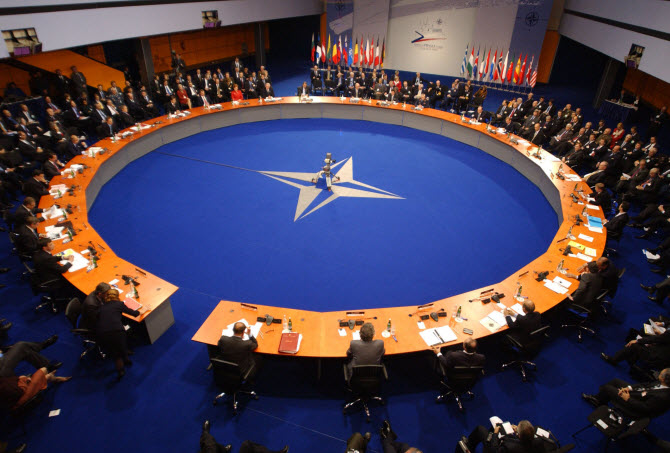
Plans are actively in motion to establish a comprehensive network of “military corridors” spanning Europe.
The primary objective is to overcome the intricate regulatory challenges that currently hinder the smooth exchange of equipment and personnel among NATO member nations. This initiative gains significance in the context of preparing for potential major conflicts, particularly with Russia.
Lieutenant-General Alexander Sollfrank, NATO’s European logistics chief, has been a proponent of this idea since November. He urged regional countries to collaborate and create zones that would facilitate the rapid and efficient movement of troops and ammunition during critical situations.
The need for such military corridors arises from the complex web of regulations within the European Union (EU), which has presented a substantial obstacle for NATO planners. The convoluted processes involved in cross-border exercises often require extensive paperwork, leading to potential delays in military responses during crises.
Discussions on the establishment of these corridors are actively underway, and there is an expectation that concrete outcomes may be announced before NATO’s upcoming summit in July. The aim is to streamline the exchange of critical resources and personnel, enabling a more efficient and coordinated response in the face of potential security threats.
Sollfrank emphasized the urgency of starting this initiative without delay, urging member nations to proactively address and minimize bureaucratic impediments.
The objective is to “reduce or adapt the red tape” wherever possible to ensure swift and effective military cooperation.
Sollfrank pointed out specific instances, such as restrictions on paratroopers using parachutes from other member states, where unnecessary barriers exist. He stressed that, unless there are genuine technical or security concerns, such impediments should be eliminated.
While there is a shared acknowledgment among military leaders regarding the need for military corridors, challenges remain.
Lieutenant General Jan-Willem Maas, head of the Defense Support Command for the Dutch armed forces, stressed that there is still much preparation needed before the envisioned network becomes fully operational.
Push for military corridors coincides with NATO’s most extensive military drills in decades
On Tuesday, Jan. 30, Germany, the Netherlands and Poland inked an agreement aimed at streamlining bureaucratic hurdles that impede the rapid cross-border movement of troops and weaponry along a key corridor from the North Sea to NATO’s eastern flank.
This development comes as a response to the heightened preparations by NATO and the EU following Russia’s invasion of Ukraine in 2022, with an anticipation of potential military conflicts with Moscow.
In the event of such a conflict, NATO allies, including the U.S., are expected to deploy significant military reinforcements through North Sea ports, traversing Germany and Poland to reach the eastern front.
Currently, NATO is engaged in its most extensive military drills since the end of the Cold War, known as Steadfast Defender 2024, involving approximately 90,000 troops.
Addressing the importance of facilitating swift military deployments, Dutch Defense Minister Kajsa Ollongren emphasized the necessity of having operational conditions in place before the outbreak of any potential conflict.
The geographical reality dictates the need for rapid movement from the Netherlands through Germany to Poland, underscoring the significance of the signed letter of intent for closer cooperation in military mobility—a project that is open to additional partners, according to the EU.
NATO has consistently highlighted the issue of excessive red tape hindering troop movements across Europe, which could result in significant delays during a potential conflict with Russia.
Sollfrank has stressed the urgency, stating that tasks not completed in peacetime will not be ready in the event of a crisis or war.
Challenges include navigating diverse regulations, ranging from advance-notice requirements for ammunition shipments to permissible convoy lengths for military movements. The cooperative agreement among Germany, the Netherlands and Poland represents a concerted effort to address these challenges and enhance the alliance’s preparedness.
RELATED ARTICLES
- After Fooling the People to Reelect Putin, Russia now announces More Cannon Fodder Mobilizations
- Russia Fires Barrage of North Korean Missiles at Kyiv After US Visit
- Ex-Wagner fighters Join Free Russia Army's Battle to Liberate Russia from Putin Occupation
- Hungary Becomes First EU Country to Congratulate Putin for Winning the 'Elections'
- Putin says NATO Troops are already in Ukraine But Russia is Still Winning












NATO want’s to establish military corridors across Europe so that NATO troops can flee for their lives in a conflict with Russia.
This military is not going to be used just for war… This will be used to keep the citizens inline, because the police forces aren’t sufficient to subdue the slaves. The citizens will be deemed terrorist for social media posts or other things that go against the controlling class. They will need a big army to enforce censorship policies. Look how they treat the protesters (whether it was the lockdown protesters or now the farmers) outside the EU parliment. Whether you agree or disagree with protester, when so many people stand up against policies, shooting them with rubber bullets and hosing them down doesn’t solve the problem. Disband NATO and the EU parliamentt!
I’m so happy that we all will die by the tens of millions AGAIN, that’s politicians are there, right? That’s why we vote. To deceive us, lie to us, steal all our money, give our jobs and industry away, and finally wage a hot war against us after injecting us poison for years and decades. F*k them all!
It’s called “freedom and democracy”, in other words, rule by banker. 84 years ago wiser and braver Germans and Europeans used to say, save us from democracy.